My five toughest Iowa football players of all time
Editor’s note: This is the second in a series in which Pat Harty from Hawk Fanatic answers a question from a fan about Hawkeye football. This series will run on a weekly basis for the remainder of the football season. Fans are encouraged to ask questions either through e-mails, social media, text messages or word of mouth. They could also reach out during the Hawk Fanatic radio show and podcast that airs on Monday, Wednesday and Friday from 9 am to 11 am on KCJJ radio.
By Pat Harty
IOWA CITY, Iowa – This is the second in a series in which I respond to a question about Hawkeye football by writing a column with my answer.
The series started with me answering what one change would I make about the Iowa football team, and my answer was for the coaches to start recruiting more mobile quarterbacks.
This week’s question didn’t have anything to do with what is, or isn’t, happening on the playing field this season.
It is more about history and about being tough and brave.
This week’s question from a fan is what five Iowa football players, past or present, would you pick to lead you down a dangerous alley or to rescue you from harm’s way.
It wasn’t the most serious of questions, but it intrigued me, and it was fun to answer.
Toughness can be defined in a number of ways that goes beyond just winning a fist fight, or knocking someone silly on the football field.
Toughness is also how a person handles a difficult situation, and how a person responds to adversity and danger.
It also helps to have size and strength when measuring toughness.
There is no right or wrong answers to this question, and there are a number of worthy candidates that didn’t make my top five.
But after giving it some serious thought, here are my top five in no particular order, along with a second top five.
- Bob Sanders: A human heat-seeking missile on the football field, he was the epitome of toughness and he played with no fear or concern for his body.
Sanders helped to lay the foundation under Kirk Ferentz, and he set the tempo more than any other player.
The Erie, Pennsylvania native was a violent and destructive strong safety, who hit so hard that you sympathized for and worried about those who crossed his path.
Sanders wasn’t a dirty player, but the way he played at Iowa two decades ago, and in the NFL, would probably be too extreme for today’s game in which player safety is emphasized like never before.
Sanders was undersized from a height standpoint at about 5-foot-8, but he was wrapped in muscles and he used Iowa’s weight training program to build not only his strength, but also his speed and quickness.
Nobody would ever replace Nile Kinnick as the greatest Hawkeye of all time, but Bob Sanders would be a close second in the opinion of many of today’s fans, and his toughness was perhaps his greatest strength.
2. Fred Becker: The Waterloo native, along with Nile Kinnick are the ultimate Hawkeye heroes, both killed while serving their country.
Becker was killed in action in World War I during the Battle of Soissons in 1918 in France. He had previously been wounded by artillery in the opening stages of the Battle of Belleau Wood on June 3, 1918. And after just a month of recuperation, he was reassigned to lead a platoon.
That led him to the battle that ultimately took his life at the age of 22.
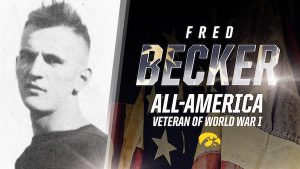
Becker had moved forward of his men and attacked machine gun nests, one of which he destroyed himself, saving the men in his platoon.
Becker was killed by an artillery shell.
For his courage and valor in battle he was awarded the Distinguished Service Cross, America’s second highest wartime honor, the Silver Star, and France awarded him the Croix de Guerre, its highest honor.
Becker only played for one season at Iowa in 1916, but he certainly made the most of it as a two-way lineman under head coach Howard Jones.
Walter Eckersall of the Chicago Tribune named Becker a first team All-American. Becker was the first Hawkeye in any sport to achieve such a high honor.
Eckersall wrote, “No matter where he was placed, his work was a feature. He was strong and powerful and quick to size up the attack of his opponents. He seldom failed to open holes for the backs and was on top of the play all year.”
3. Duke Slater: He was a star lineman in the early 1920s despite not wearing a helmet, because according to reports, he couldn’t afford one.
It would be easy to dismiss this as hyperbole or make believe, but there are photos that show him blocking without a helmet.
Slater didn’t just block without a helmet; he dominated without a helmet.
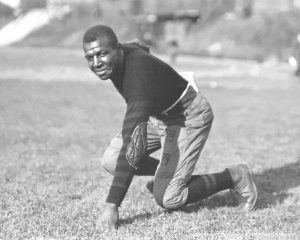
He has the distinction of being Iowa’s first black player to earn All-America honors for his play in the trenches.
And again, he did it without wearing helmet.
The game has changed dramatically from a player safety standpoint, and for good reason, but Slater remarkably made it through years of playing in the trenches, including much of it without wearing a helmet, and would go on to become an attorney and the second African-American judge in Chicago history.
Slater played college football at Iowa from 1918 to 1921. He played the tackle position and was a first-team All-American in 1921 for a team that finished undefeated. Slater joined the NFL the following year, becoming the first black lineman in league history. He played 10 seasons in the NFL and made all-pro seven times.
The field at Kinnick Stadium is named in Slater’s honor, as is a dormitory on the UI campus.
4. Andre Tippett: His Iowa teammates didn’t just respect Andre Tippett, they feared him because he was so tough and determined, on and off the field.
In addition to being a ferocious pass rusher who helped lay the foundation under Hayden Fry, the New Jersey native is also a master of martial arts as a black belt in karate.
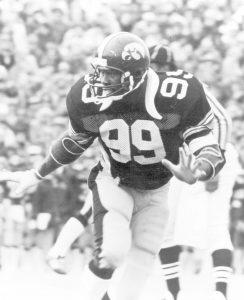
Tippett first took up martial in 1972 as a 12-year kid and long before he started terrorizing quarterbacks on the football field.
Football made Tippett rich and famous, but marital arts made him who is today.
Tippett played 11 seasons in the NFL with the New England Patriots and was inducted into the NFL Hall of Fame in 2008.
He was the heart and soul of one of the greatest Iowa’s defenses ever in 1981, and his toughness was contagious.
Tippett and his defensive cohorts, along with punter Reggie Roby, paved the way to a Big Ten title in 1981 and to a berth in the Rose Bowl.
Tippett played one season for Ellsworth Community College in Iowa Falls before transferring to Iowa in 1979.
It was soon realized after he became a Hawkeye that you didn’t mess with Andre Tippett.
5. Calvin Jones: The easy thing would’ve been to stay home and be a Buckeye, be an in-state hero and be under the guidance of the legendary Woody Hayes.
But lineman Calvin Jones chose a different path, a path in which his close friends from Steubenville, Ohio could travel with him.
Jones was part of the legendary Steubenville trio at Iowa, along with running back Eddie Vincent and end Frank Gilliam.
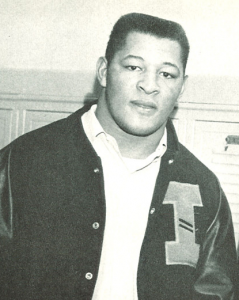
The three high school buddies seized the opportunity to play for a Big Ten program that was ahead of its time with race relations as Iowa was willing to give scholarships to all three of them when most other schools wouldn’t.
Forest Evashesvki was an intimidating and scary force of nature, who could be petty and vindictive according to those who knew Iowa’s head football coach from 1952 to 1960.
But Evashevski was also a coaching legend who lifted Iowa to a level of success that still ranks as the best in program history, and he was a pioneer in the pursuit of racial equality.
Evashevski’s willingness to recruit black players when few other head coaches would was partly self-serving because he knew talent when he saw it.
But Evashevski was also willing to support a cause that faced strong resistance at that time.
All three members of the Steubenville trio had success at Iowa, but Jones was without question the leader as he and Nile Kinnick are the only Iowa football players to have their jersey number retired.
Sadly, his life ended way too early as Jones was killed in a plane crash on Dec. 8, 1956 at the age of just 23.
My second five:
Alex Karras: He won the Outland Trophy in 1957 and then played 13 seasons in the NFL before enjoying a long and successful career in broadcasting and as an actor. He was a force in the trenches, and his toughness was a big factor in his success.
Matt Roth: His motor never seemed to stop on or off the field as a hard-charging defensive end. He was exactly who you wanted on your side in a street brawl.
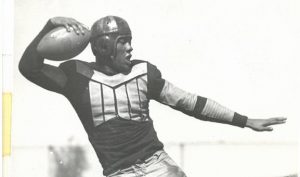
Mark Bortz: He was a powerful and nasty defensive lineman at Iowa who would go on to have a long and distinguished career as an offensive lineman for the Chicago Bears.
Todd Simonsen: This pick was personal for me as he and my older brother, Frank Harty, were in the same 1978 recruiting class and would become close friends. Todd was the epitome of toughness as a middle linebacker and he feared nobody on or off the field.
Sadly, Todd passed away in 2007 from Lymphoma at the age of 47. His death is one of the few times I remember my brother crying.
Ozzie Simmons: He was an electrifying running back for the Hawkeyes in the mid-1930s when very few African-Americans played college football.
He was also the inspiration for Floyd of Rosedale, a tradition that started from the physical and verbal abuse that Simmons suffered on the field against Minnesota.
Simmons was a marked man simply because of his skin color, but he never backed down from the threats or from the danger, and that says a lot about his courage and toughness.



